In This Issue
- Shawn DuBravac Intro
- IoT Will Dominate CES
- Why IoT Will Dominate
- Report from the CEO
- CES IoT and Lot More
- Connected Home Big
- Samsung IoT Focus
- Intel IoT to the Cloud
- IoT to Boom in 2015
- 2015: The Year of IoT
- SOs, Infs, Svcs in IoT
- Industrial IoT on Way
- Cloud and Big Data
- What to Expect 2015
- Cloud Still Has Legs
- Apps Drive Big Data
- Coming DCIA Events
Shawn DuBravac to Introduce DCIA’s IoT Marathon
 The Distributed Computing Industry Association (DCIA) is pleased to announce that Shawn DuBravac will present the introductory segment of the DCIA’s Internet of Things (IoT) Marathon webcast being produced during the upcoming 2015 International CES.
The Distributed Computing Industry Association (DCIA) is pleased to announce that Shawn DuBravac will present the introductory segment of the DCIA’s Internet of Things (IoT) Marathon webcast being produced during the upcoming 2015 International CES.
Shawn DuBravac, CFA, is the Chief Economist for the Consumer Electronics Association (CEA), where he directs CEA’s economic analysis.
In this capacity he is responsible for handling analysis of the economy as it relates to the consumer electronics industry including forecasting future economic activity, econometric studies, examining trade flows, and ascertaining relative health of the industry.
Dr. Shawn DuBravac also provides research into the technology trends underpinning the industry and quantitative support for CEA’s legislative initiatives.
At the 2015 CES, his new book, Digital Destiny: How the New Age of Data Will Transform the Way We Work, Live, and Communicate will make its debut.
In “Digital Destiny,” Shawn DuBravac explains that the world’s mass adoption of digital technologies portends the beginning of a new era for humanity, one that will rival the invention of the printing press for its transformational effects on every person, country, and institution in the world.
IoT Will Dominate 2015 International CES
Excerpted from Mobile Enterprise Report
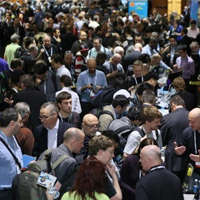 The Consumer Electronics Association (CEA) announced that the 2015 International CES – taking place January 6-9 in Las Vegas, NV – will feature the largest ever showcase of products, services, and technologies that make up the Internet of Things (IoT), with more than 900 exhibitors planning to share innovations that harness the power of the network to connect everyday devices.
The Consumer Electronics Association (CEA) announced that the 2015 International CES – taking place January 6-9 in Las Vegas, NV – will feature the largest ever showcase of products, services, and technologies that make up the Internet of Things (IoT), with more than 900 exhibitors planning to share innovations that harness the power of the network to connect everyday devices.
“The IoT is the hottest topic in tech right now,” said Karen Chupka, Senior Vice President, International CES and Corporate Business Strategy, CEA.
“It’s all about the opportunity to connect everyday items like cars, home security systems, and kitchen appliances to networked devices like PCs and smartphones for greater control and management of our everyday lives. We’re excited that the 2015 CES will bring together all of the companies and products that are making this a reality.”
The Sensors Marketplace will highlight one of the key technologies that is enabling the IoT. In addition, the Smart Home Marketplace will showcase a smarter, more efficient home accelerated by smartphones and tablets interacting with a myriad of connected objects and devices, from basic security systems to connected lighting systems.
2015 CES keynoters Boo-Keun Yoon, President and CEO of Samsung Electronics, and Brian Krzanich, CEO of Intel, are expected to share their insights on IoT innovations. Other CES conference programming will also explore the future of this trend. Read more…
Why IoT Will Dominate CES 2015 in a Big Way
Excerpted from TechFirstPost Report by Shruti Dhapola
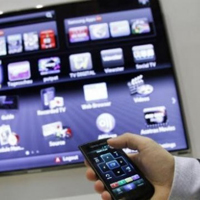 The International Consumer Electronics Show (CES) 2015 is one of the most awaited tech events for those wishing to see what the latest developments and trends in technology are likely to be.
The International Consumer Electronics Show (CES) 2015 is one of the most awaited tech events for those wishing to see what the latest developments and trends in technology are likely to be.
The event isn’t just about smartphones and tablets, but about the kind of technology that will be big soon – maybe not in 2015 but perhaps in the coming decade.
The highlight of CES 2015 will be The Internet of Things (IoT), and how it will change our lives radically.
For the uninitiated, IoT will mean the next level of evolution for the Internet, where even daily household objects such as television sets, cars, homes, and kitchen appliances, are all connected to the web.
Not only is IoT expected to change how we interact with products, but it will also become a booming industry – as research firm IDC has predicted that by 2020 IoT will be a $3 trillion industry.
For starters, according to CES’s press statement, this year’s show will have the largest collection of products, services, and technologies that make up the IoT.
It all sounds very much like science-fiction, but the reality is that these changes are already taking place. As we saw in 2014, Apple,Google, Samsung, and just about everyone is taking this idea very seriously. Read more…
Report from CEO Marty Lafferty
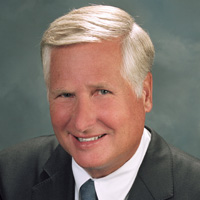 The Distributed Computing Industry Association (DCIA) is very excited to enter into the production phase of “DCIA’s Internet of Things (IoT) Marathon” webcast this week during the 2015 International CES.
The Distributed Computing Industry Association (DCIA) is very excited to enter into the production phase of “DCIA’s Internet of Things (IoT) Marathon” webcast this week during the 2015 International CES.
The IoT is now on an unstoppable growth trajectory to surpass 50 billion smart objects and $3 trillion in revenue by 2020.
Twelve hours of demos, displays, and discussions focusing on this newest and arguably largest-ever industry phenomenon will be recorded in HD-video for this major industry webcast in DCIA’s production studio at the Sands Expo & Convention Center.
Additional recordings will take place at IoT related events and in meeting rooms and exhibit suites throughout CES.
Information about participating will be available at the DCIA Exhibit Booth in the South Hall of the Convention Center.
CES delegates involved with connected consumer devices, wearables, machine-to-machine (M2M) solutions, radio-frequency identification devices (RFID), remote monitoring and maintenance solutions, micro-sensors, trusted computing, smart environment architectures, and related examples of the emerging IoT phenomenon are encouraged to participate.
Industry analysts and observers are also invited to provide their perspectives and insights.
DCIA’s IoT Marathon will showcase industry-leading developments in smart objects for fitness and healthcare; programmable homes and energy management; media entertainment and social networking solutions; geolocation services and vehicular automation; retail, public space and manufacturing environments; and power consumption, cybersecurity, and interoperability.
The 2015 CES is the ideal place to start learning in-depth about the multiplicity of opportunities that this rapidly emerging movement offers product developers, software engineers, marketers, entrepreneurs, and other forward-looking professionals across many economic sectors.
The DCIA supports industry efforts to improve efficiency and reduce power consumption, address cybersecurity and related vulnerabilities, establish common protocols and communications standards for interoperability and connectivity among various devices, and enhance ease-of-use for consumers.
Share wisely, and take care.
CES 2015: The Internet of Things and a Lot More
Excerpted from Guardian Liberty Voice Report by Judith Aparri
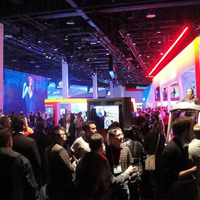 CES 2015 will be about the Internet of Things (IoT) and a lot more. Samsung Electronics invites delegates to attend the opening keynote of CEO and President BK Yoon about how the IoT will change lives and revolutionize the industry.
CES 2015 will be about the Internet of Things (IoT) and a lot more. Samsung Electronics invites delegates to attend the opening keynote of CEO and President BK Yoon about how the IoT will change lives and revolutionize the industry.
The Consumer Electronics Show is a tech calendar event that mostly sets the innovation tone for the next year. The upcoming CES is about to kick-off in Las Vegas and will last until January 9th.
The annual event for the good and the great of the tech world, who gather in Las Vegas to present their most recent inventions, will have something for everyone. Products showcased at the CES event are always new and glimmering, but what is more exciting is the technology behind them. Aside from new products, CES will also have conferences, which will focus on the coming trends of the tech sector.
Fitness and health may take the center stage. To be included in discussions are the tech for athletes and the next biometric headphone that monitors physical performance and heart rate, while the user is listening to music.
Intel’s Vice President will present tech-making wearables. Famous health-tracking firms like iFit, Fitbit, and Withings will have booths, while the WebMD CEO will talk about what is next with do-it-yourself (DIY) health tech on January 7th.
Among the products to be featured will be Bluetooth pacifier. It is the world’s first health tracker for babies, which syncs to the smartphones of parents and gives the baby’s temperature. Read more…
“The Connected Home” Is Going to be Big at CES
Excerpted from USA Today Report by Jon Swartz
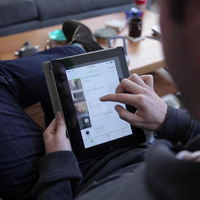 Jefferson Graham visits a working smart home in Redondo Beach,CA where an app by Belkin turns on the lights, opens the garage door, starts the morning coffee, and more.
Jefferson Graham visits a working smart home in Redondo Beach,CA where an app by Belkin turns on the lights, opens the garage door, starts the morning coffee, and more.
The smart home is showcasing Belkin’s WEMO products. Click here for the video by Sean Fujiwara.
Home, suite home.
The connected home is edging toward widespread reality after years of promise and more than a fair amount of hype.
It will be a major topic of conversation at the Consumer Electronics Show in Las Vegas, where Samsung ElectronicsCEO Boo-Keun Yoon is scheduled to deliver a keynote speech on the Internet of Things (IoT) on January 5th.
Several major vendors, including GE, plan to display their wares in a smart home exhibit at CES.
Wireless devices that monitor and adjust a house’s temperature, lighting, and security systems are sprouting in homes and apartments as televisions did in the 1950s, microwaves in the 1970s, and flat-screen TVs in the 2000s.
“We’re still in the age of educating consumers, who have not embraced the concept yet,” says Michael Wolf, Chief Analyst at NextMarket Insights, a market-research firm. “Perhaps, Apple or Google will build something that ties it all together.”
Samsung Electronics to Focus on Internet of Things
Excerpted from Global Post Report
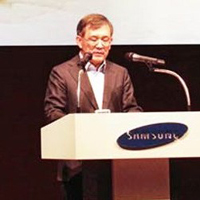 Samsung Electronics will focus on the Internet of Things (IoT) in 2015 as one of the new growth engines along with the business-to-business (B2B) sector, software content, and service platforms.
Samsung Electronics will focus on the Internet of Things (IoT) in 2015 as one of the new growth engines along with the business-to-business (B2B) sector, software content, and service platforms.
Samsung chief executive Kwon Oh-hyun said in his New Year’s remarks to employees that the company should actively push for new business in the IoT, including smart health and smart home, to secure a future competitive edge.
Kwon said the company should continue its growth in B2B businesses by creating new demand, stressing the need for stronger service platforms to enhance the company’s competitiveness in content and services.
The IoT is a technology that links everyday things, such as mobile devices and home appliances, to the Internet. For example, you can start the engine of your car by pressing smartphone buttons and raise the temperature of your home by controlling the Internet-connected thermostat from outside of your home.
IoT is expected to boost the revenue of Samsung Electronics, which makes almost everything from mobile phones and televisions to washers and refrigerators.
Samsung, best known as the world’s No.1 smartphone maker, saw its revenue fall sharply last year as smartphone sales reduced, partly on the rise of Chinese manufacturers armed with low-end models.
Samsung’s global market share in smartphones declined 7.7 percentage points from a year earlier. Read more…
Intel Driving IoT towards the Cloud
Excerpted from Talkin’ Cloud Report by Mike Vizard
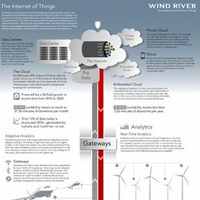 Going into 2015, there is certainly a buzz surrounding anything to do with the Internet of Things (IoT). The challenge is that building IoT solutions represents a massive investment in what are largely unproven applications.
Going into 2015, there is certainly a buzz surrounding anything to do with the Internet of Things (IoT). The challenge is that building IoT solutions represents a massive investment in what are largely unproven applications.
To help reduce that risk, Wind River, a unit of Intel that specializes in embedded systems running a distributed of Linux that it developed, has launched the Wind River Edge Management System, a cloud service that provides a central console for managing devices connected to the Internet.
Intel has a vested interest in all thing IoT because most of the gateways that devices will be connected to the Internet through are essentially going to high-margin x86-class servers. Those gateways in turn will drive demand for application workloads deployed in private and public cloud services, most of which will be running on x86 servers.
In the case of the Wind River Edge Management System, agent software running on the end-point enables data capture, rules-based data analysis, and response, configuration, and file transfer.
Ido Sarig, General Manager for IoT Solutions at Wind River, said Wind River is not only looking to solution providers in the channel to integrate IoT devices and gateways, but also to build applications that address innovative IoT use cases.
After all, while IoT has a lot of potential, most businesses don’t really understand how to best apply it. Read more…
Internet of Things to Boom in 2015
Excerpted from Kioskea Report by Nicole Motta
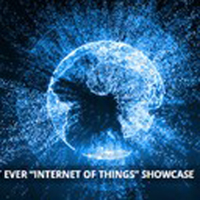 The Internet of Things (IoT) is taking off, with 2015 set to be the Year of IoT, though what that means and where that will take us is still unclear.
The Internet of Things (IoT) is taking off, with 2015 set to be the Year of IoT, though what that means and where that will take us is still unclear.
It has yet to be decided what 2014 will stand for as the year comes to a close.
Some say 2014 will be known as the “Year of the Hacker” with devastating attacks on Sony Pictures, JPMorgan,Snapchat, online gaming platforms Xbox Live and PlayStation Network, retail stores Target and Home Depot, and many more.
Earlier this year, CNN Money reported that nearly half of all American adults have been hacked, a number that has likely grown since May’s report and is expected to continue to rise.
Others, like the Computer Electronics Association’s Jim Barry, think 2014 will be looked back on as the “Year Drones Took Off.”
Barry notes four main advancements that have started to push unmanned aerial vehicles into the consumer sector: the marriage of drones and action camcorders; smartphone controls; consumers’ increasing desire to share and record day-to-day activities on social media; and more robust wireless connections. Drones will have their own session at the Consumer Electronics Show. Read more…
Why 2015 Will Be the Year of the IoT
Excerpted from Business Spectator Report by Geoff Webb
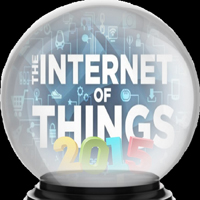 We’ve been talking about the Internet of Things (IoT) for what feels like years now. Yet the reality is that while it’s quickly starting to dominate technology conversations, it’s still a new and not broadly understood trend.
We’ve been talking about the Internet of Things (IoT) for what feels like years now. Yet the reality is that while it’s quickly starting to dominate technology conversations, it’s still a new and not broadly understood trend.
According to research analyst group IDC, the worldwide IoT market will increase 133 per cent to $3.04 trillion in 2020 while the number of IoT-connected units will reach approximately 50 billion in 2020. The forecast predicts vendors, service providers, and systems integrators will have to find ways to integrate products and solutions in order to be successful in the market.
As with any other potentially highly disruptive trend, we tend to develop a sense of buzzword fatigue long before the real impact is felt. This is especially true for IoT if for no other reason than so many people are discussing it in so many different contexts. But it would be a mistake to underestimate both the rapidity of change and the impact of the IoT.
It’s moving fast – far faster than anything we’ve seen before. From early thinking around smart devices to the current developments in connecting home management, appliance, and car computers to form a much smarter ‘home’ experience. What we’re seeing is one part of the IoT building on others, and as each layer gets deployed, so it opens up more opportunities to create new smarter technologies. The effect is shifting from additive to geometric, and we should expect to see this really accelerate next year. We’re not overstating the rate of growth of the IoT, we’re chronically underestimating it.
As the IoT grows, so the impact of the technologies will grow with it. Read more…
Smart Objects, Infrastructures, and Services in the IoT
 The Internet of Things (IoT) is a novel paradigm that is shaping the evolution of the future Internet. According to the vision underlying the IoT, the next step in increasing the ubiquity of the Internet is to connect inanimate objects.
The Internet of Things (IoT) is a novel paradigm that is shaping the evolution of the future Internet. According to the vision underlying the IoT, the next step in increasing the ubiquity of the Internet is to connect inanimate objects.
By providing objects with embedded communication capabilities and a common addressing scheme, a highly distributed and ubiquitous network of seamlessly connected heterogeneous devices is formed, which can be fully integrated into the current Internet and mobile networks.
Thus, it allows for the development of new intelligent services available anytime, anywhere, and by anyone and anything.
When human interaction is absent from the system dynamics, the vision is also referred to as machine-to-machine (M2M) communications. Many applications with high social and business impact fall under the IoT/M2M umbrella, including personal healthcare, smart grids, smart city, surveillance, home automation, and intelligent transportation; and it is strongly expected that new applications will emerge once the enabling technologies reach a stable state.
The aim of this special issue, for which we are issuing a call for papers, is to bring together practitioners and researchers from both academia and industry to discuss recent advances in theory, application, and implementation of the IoT technologies, protocols, algorithms, and services. Read more…
Industrial Internet of Things Is on its Way
Excerpted from EE Times Report by Rich Quinnell
 When looking at the consumer side of the Internet of Things (IoT), it is easy to conclude that the IoT is still mostly hype. There are many products being introduced with little more to offer than novelty and a slight increase in convenience. But there is still little of the synergy that the IoT is expected to manifest, and little of measurable value yet to arise.
When looking at the consumer side of the Internet of Things (IoT), it is easy to conclude that the IoT is still mostly hype. There are many products being introduced with little more to offer than novelty and a slight increase in convenience. But there is still little of the synergy that the IoT is expected to manifest, and little of measurable value yet to arise.
The industrial applications of the IoT, on the other hand, are proving themselves. Intel, for instance, ran a trial at its plant in Penang, Malaysia, saving some $9 million by increasing productivity, reducing component failures, and improving equipment uptime. And this was simply by instrumenting one component of the production line: the CPU testers. An analysis by David Floyer, CTO of information resource Wikibon, shows the increases in efficiency of industrial plant equipment as well as reductions in maintenance that IoT implementations provide were always at least 10% and could range as high as 25%.
Industries are responding to this proven ROI by beginning to adopt IoT technologies across the board. According to survey results reported by Business Insider, some 18% of industrial machinery companies are already using IoT in some capacity. Business projections by Floyer predict an investment of some $500 billion in industrial IoT by 2020, with an annual value returned of up to $1.2 trillion.
These early results are primarily from point solutions, however. Read more…
IT World Looks to Cloud and Big Data for Growth in 2015
Excerpted from Financial Post Report by Lynn Greiner
 Every year around this time, we get inundated with predictions of what to look for in IT when the calendar turns.
Every year around this time, we get inundated with predictions of what to look for in IT when the calendar turns.
Sometimes those forecasts come true, sometimes they’re merely wishful thinking; but it’s usually interesting to see what the pundits believe is in store.
Let’s take a peek into their crystal balls.
International Data Corporation (IDC) analysts made a series of predictions, some rather startling, about the cloud.
For example, they said that three quarters of Infrastructure as a Service (IaaS) offerings would be redesigned, rebranded, or discontinued in the next 12-to-24 months, despite the expectation of rapid growth as competitors rise up to challenge market leader Amazon.
And by 2016, more than half of organizations building hybrid clouds will acquire workload-aware cloud management products; 65% of the criteria used to choose which workloads will be cloud-ified will be tied to data privacy regulations.
“Digitization and transformation to virtualized, on-demand provider-based services are driving very rapid internal IT change,” said Robert Mahowald, Program Vice President at IDC SaaS & Cloud Software research practice. “IT buyers are shifting steadily toward cloud-also and cloud-first strategies and nearly all are reconsidering their IT best practices to embrace hybrid cloud construction and operations.” Read more…
What We Can Expect from Cloud Computing in 2015
Excerpted from ITPro Portal Report by Len Padilla
 It’s been a fascinating 2014 for the cloud. Some very niche technologies are hitting the mainstream, while the debate over data protection and governance clearly isn’t going away anytime soon.
It’s been a fascinating 2014 for the cloud. Some very niche technologies are hitting the mainstream, while the debate over data protection and governance clearly isn’t going away anytime soon.
So, we predict the cloud will rise high in 2015 – but how (and where) it is tethered to the ground will matter more than ever.
Software Defined Networking (SDN) and Network Functions Virtualization (NFV) have become well established within the telecom industry, where they have helped service providers industrialize and automate their service delivery to a large extent.
In the enterprise, however, the familiar hodge-podge of switches, firewalls, and routers still remains. But with vendors of all sizes starting to build the open SDN and NFV specifications into their hardware, IT departments will soon enjoy cloud-like levels of automation within their own environments.
The logical conclusion of this is that the lines dividing the management and delivery of cloud and IT services will become increasingly blurred, allowing organizations to consolidate their entire IT Service Management capability within a single environment.
Container technology has morphed from a niche open-source project to a serious contender in the virtualization realm. It’s not hard to see why. Containers offer a new, much faster way of provisioning multiple platforms on shared infrastructure. Read more…
Cloud Computing Will Continue to Have Legs in 2015
Excerpted from GigaOM Report by Sam Dean
 To guage how hot open cloud computing is, check the job listings. Opportunities abound for those with OpenStack skills, for example.
To guage how hot open cloud computing is, check the job listings. Opportunities abound for those with OpenStack skills, for example.
But there are strong signs that some of the big growth in cloud computing may lie ahead, and Amazon, the 800-pound gorilla in the cloud, may face much stiffer competition.
The cloud infrastructure market was $3.6 billion last year, reports IDC, but it will expand 31 percent a year through 2018. Amazon owns 40 percent of the market says IDC. In most market-share reports, Microsoft, Google, and IBMeach have under 10 percent of the market.
Meanwhile, the OpenStack Foundation’s survey from late last year showed very clearly that some IT departments were still evaluating OpenStack instead of actually deploying it.
In a recent appearance at the HP Discover Conference in Barcelona, Tom Norton, head of HP’s OpenStack Services Group, said that trend may still be in place. Most customers “are still looking at OpenStack for a singular workload or looking for an environments that supports a test case,” he said, citing OpenStack’s complexity.
In 2015, we are likely to see many more actual deployments of OpenStack. Meanwhile, many news outlets are covering the close competition in public cloud services. Read more…
Applications Drive the Biggest Money in Big Data
Excerpted from ReadWrite Report by Matt Asay
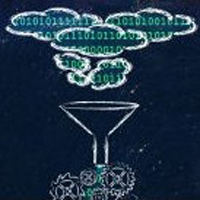 We’re still fixating on all the wrong Big Data start-ups.
We’re still fixating on all the wrong Big Data start-ups.
Hortonworks, one of the primary companies behind Hadoop, recently went public to great fanfare and a $1.2 billion valuation. But Hortonworks and the rest of the so-called Big Data start-ups are actually some of the least interesting Big Data companies.
In fact, of the current crop of 40 start-ups valued at more than $1 billion, virtually none of them sell Big Data technology like Hadoop. But all of them make heavy use of data – lots of it – to deliver a wide array of services.
As consultant Peter Goldmacher declared back in 2013, the biggest winners in Big Data are the “business people that have identified opportunities to use data to create new opportunities or disrupt legacy business models.”
As we enter 2015, expect to see data double the number of billion-dollar start-ups even as public companies learn to grow through data, as well.
It used to be enough for a vendor to ship software and abandon the customer to figure it out (or pay hefty sums of money in consulting fees). SAP, for example, has made billions in revenue by shipping complex software and having customers shell-out multiples of the software license fee for high-priced consultants to make sense of its Byzantine software. That sort of strategy doesn’t work very well anymore. Forget start-ups for a moment. Read more…
Coming Events of Interest
Storage Visions Conference — January 4th-5th in Las Vegas, NV. The fourteenth annual conference theme is: Storage with Intense Network Growth (SWING). Storage Visions Awards presented there cover significant products, services, and companies in many digital storage markets.
International CES — January 6th-9th in Las Vegas, NV. The International CES is the world’s gathering place for all who thrive on the business of consumer technologies. Held in Las Vegas every year, it has served as the proving ground for innovators and breakthrough technologies for more than 40 years — the global stage where next-generation innovations are introduced to the marketplace.
The DCIA’s IoT Marathon — January 6th-9th in Las Vegas, NV. Twelve hours of demos, displays, and discussions of all aspects of the Internet of Things (IoT) in daily segments recorded in the DCIA’s HD-video webcast studio at the Sands Expo and Conference Center.
State of the Net Conference — January 27th in Washington, DC. With unparalleled opportunities to network and engage on key Internet policy issues, this is the largest Internet policy conference in the US and is recognized for its balanced blend of private and public sector participants.
Datacloud South East Asia — March 25th-26th in Johor, Malaysia. Datacloud South East Asia will assess the energy, scalability, security, architecture, and software challenges confronting operators of data centers and enterprises engaged in or considering transitions to the cloud.
Internet of Things Conference — April 15th-17th in San Diego, CA. The IoT Con will focus on how companies are using a variety of technologies, including ZigBee radios, Wi-Fi, and machine-to-machine (M2M)software, to connect things to the Internet, and how they are achieving real business benefits from doing so.
Internet of Things World Forum (IoTWF) — October (2015 Dates TBD) in Dubai, UAE. IoTWF is an exclusive event that brings together the best and brightest thinkers, practitioners, and innovators from business, government, and academia to accelerate the market adoption of the Internet of Things.
